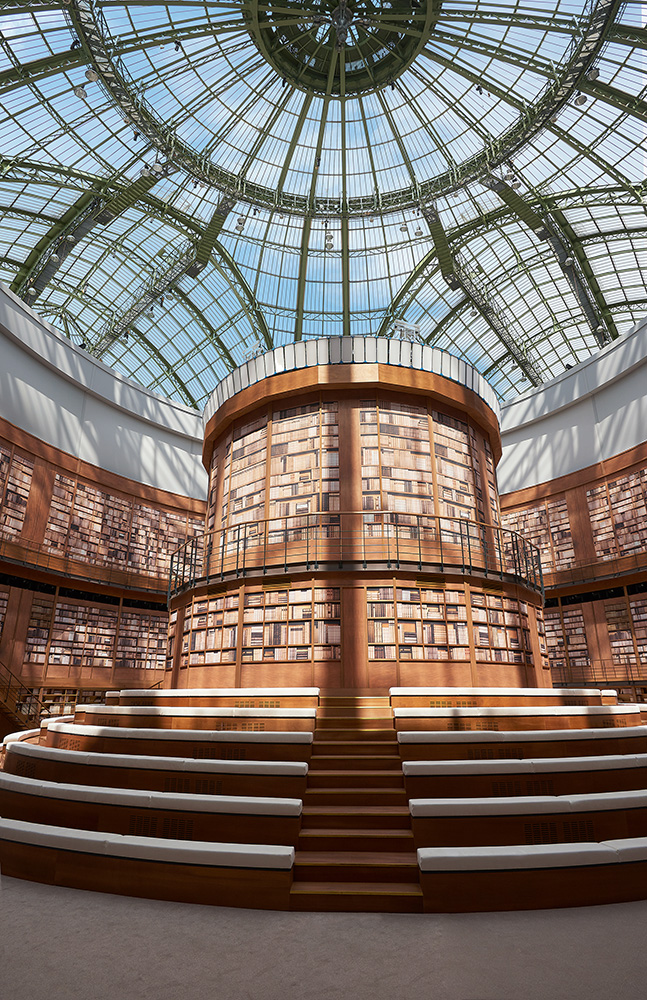“Books are my best friends”, Gabrielle Chanel confided one day to the writer Paul Morand. Ever since her childhood spent alone at the Aubazine orphanage, books had been a vital part of Gabrielle Chanel’s life. The characters of the novels she devoured in her youth opened doors into dream worlds, an escape where her destiny was drawn out, where she found the strength to work on accomplishing the building of her oeuvre, just like a writer. It was undoubtedly literature that drove her to imagine this understated and timeless allure that was inscribed, like her, in a perpetual modernity. Jean Cocteau wrote about her: “She, by some sort of miracle, operated in fashion by following rules that seemed only to be valid for painters, musicians, poets. She imposed the invisible, she imposed the nobility of silence on the furore of high society.”

In her apartment on rue Cambon, glasses lying on her desk next to an open book. We can imagine Gabrielle Chanel resuming her reading after a fitting at the studio, reclining on her fawn suede divan with quilted cushions. All around, her salon walls literally covered with books, watching over her like benevolent and protective talismans. There is no question of her unconditional love for books. The leathery perfume of antique bindings mixing with that of N°5, the elegance of the gilded engravings on the back of the books, the caress of the paper, the crackling of the pages as they’re turned one by one. Between them extraordinary conversations seem to take place in whispered words: Shakespeare, Montaigne and La Rochefoucauld talk to La Bruyère, Racine, Molière and Saint-Simon. Rousseau and Voltaire, Pascal and Bossuet, Madame de Sévigné and Stendhal, Flaubert and Proust all smoothly interact.
And then of course there’s the poets, Baudelaire, Verlaine, Mallarmé, Apollinaire, Rilke, not to mention her friends Jean Cocteau, Max Jacob and Pierre Reverdy. Poetry… one of Gabrielle Chanel’s passions, a taste she developed alongside Boy Capel. After the death of her great love, the works of poets became precious relics, like reassuring presences of cherished memories that Gabrielle Chanel could peruse in the silence of her reading.

“If today you open a history of our literature, you should find there the name of a new classical author: Coco Chanel. Chanel does not write with paper and ink (except in her leisure time), but with material, with forms and with colors; however, this does not stop her being commonly attributed with the authority and the panache of a writer of the classical age: elegant like Racine, Jansenist like Pascal (whom she quotes), philosophical like La Rochefoucauld (whom she imitates by delivering her own maxims to the public), sensitive like Madame de Sévigné […]” wrote Roland Barthes in 1967. The vocabulary and the style of CHANEL have imposed themselves as naturally as the texts of the great classical authors.
Himself an unconditional lover of books, Karl Lagerfeld continued this artistic dialogue. In his personal libraries, in his offices and in the photo studio of his 7L bookstore, the designer collected more than 300,000 books. “It’s an illness, I’m not afraid to admit it […] My library is incredibly varied, there are quite a few biographies […] but also lots of albums, art books. You see how consuming this passion is!”, the couturier confided.

An insatiable and erudite collector, Karl Lagerfeld shared his passion for books and literature with Virginie Viard for nearly thirty years. A diligent reader, the Artistic Director of the Fashion Collections now pays tribute to this love with the décor of her first Haute Couture collection for CHANEL. Thousands of books line wooden shelves, forming an impressive circular library with passageways, arranged like a peaceful reading room.
Words and style, literature and fashion: so many inspiring and unique conversations imagined by Virginie Viard today and which she expresses through her vision of the allure of CHANEL.




Comments are off this post!